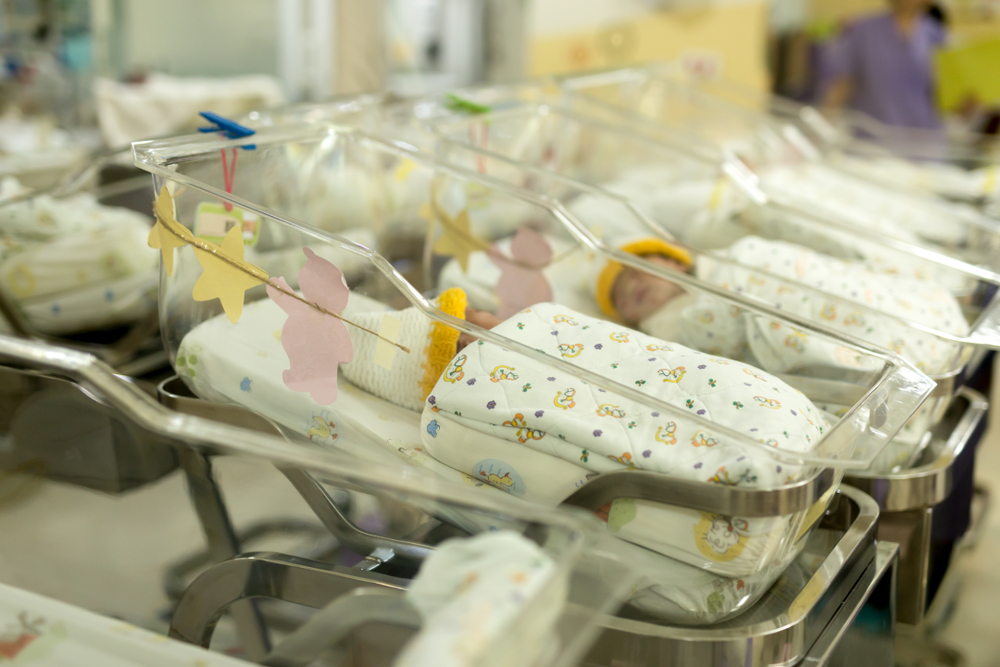This content was originally posted on the American Academy of Pediatrics website.
Based on current limited evidence, the Frequently Asked Questions below provide initial guidance for the management of infants born to mothers with confirmed and suspected COVID-19.
See the full Interim Guidance report here.
Q: What precautions should I take to attend a delivery from a mother with COVID-19?
A: Use gown and gloves, with either an N95 respiratory mask and eye protection goggles; or with an air-purifying respirator that provides eye protection. This protection is needed given both the increased likelihood of maternal virus aerosols and the potential need to perform newborn resuscitation that can generate aerosols (bag-mask ventilation, intubation, suctioning, oxygen at a flow >2 LPM/kg, continuous positive airway pressure and/or positive pressure ventilation).
Q: Can mother and well newborns room-in?
A: While difficult, temporary separation of mother and newborn will minimize the risk of postnatal infant infection from maternal respiratory secretions. Ideally admit infant to an area separate from unaffected infants and use gowns, glove, eye protection goggles and standard procedural masks for care of well newborns. Any temporary separation of mother and newborn is acknowledged to be challenging. If mother chooses to room-in despite recommendations; or if your center cannot provide the infant a separate area, the infant should remain at least 6 feet from mother. Curtain placement or use of an isolette may facilitate separation.
Q: Can the baby breast feed?
A: Studies to date have not found SARS-CoV-2 in breast milk. Mothers may express breast milk after appropriate breast and hand hygiene, and this may be fed to infant by uninfected caregivers. If the mother requests direct breastfeeding, she should comply with strict preventive precautions, including the use of mask and meticulous breast and hand hygiene.
Q: What should I do if the baby requires intensive care?
A: Infants requiring neonatal intensive care optimally should be admitted to a single patient room with the potential for negative room pressure (or other air filtration system.) If this is not available, or if you must cohort multiple COVID-exposed infants, maintain at least 6 feet between infants and/or place them in air temperature-controlled isolettes. Use gown and gloves, with either an N95 respiratory mask and eye protection goggles; or with an air-purifying respirator that provides eye protection, for care of infants requiring supplemental oxygen at a flow >2 LPM/kg, continuous positive airway pressure, or mechanical ventilation.
Q: Should I test babies to determine if they are infected with SARS-CoV-2?
A: If available, testing well newborns will facilitate plans for care after hospital discharge; will determine the need for ongoing precautions and use of personal protective equipment among hospitalized infants; and will contribute to our understanding of viral transmission and newborn illness.
- Newborns should be bathed after birth to remove virus potentially present on skin surfaces.
- Testing should be done first at ~24 hours of age
- Repeat testing should be done ~48 hours of age, unless the infant is discharged home prior to this time
- Use one swab to sample first the throat and then the nasopharynx. Place single swab in one viral transport media tube and send to lab for molecular testing
- For infants who are positive on their initial testing, follow-up testing of combined throat/nasopharynx specimens should be done at 48-72 hour intervals until two consecutive negative tests
Q: What do I do when the baby is ready for hospital discharge?
A: Discharge newborns based on your center’s normal criteria.
If infant SARS-CoV-2 testing is positive, but infant has no symptoms of COVID-19, plan for frequent outpatient follow-up (either by phone, telemedicine, or in-office) through 14 days after birth. Use precautions to prevent household spread from infant to caregivers; see the CDC guidance on use of standard procedural masks, gloves and hand hygiene in the home environment.
If infant SARS-CoV-2 testing is negative, discharge ideally to the care of a designated healthy caregiver. While challenging in the home environment, mother should maintain a distance of at least 6 feet when possible, and use a mask and hand-hygiene when directly caring for the infant, until EITHER (a) she has been afebrile for 72 hours without use of antipyretics, and (b) at least 7 days have passed since her symptoms first appeared; OR she has negative results of a SARS-CoV-2 test from at least two consecutive specimens collected ≥24 hours apart. Other caregivers in the home who are persons under investigation (PUIs) for COVID-19 should use standard procedural masks and hand hygiene when within 6 feet of the newborn until their status is resolved. Every effort should be given to provide education to all caregivers of the infant, which includes not only written education but also verbal education in person, via telephone or virtually. Interpreter services should be utilized where appropriate.
If baby cannot be tested, then treat the baby as if virus-positive for the 14-day period of observation. Mother should still maintain precautions until she meets the criteria for non-infectivity as above.
Q: When can I let the mother and her partner visit their newborn if the baby is in the NICU?
A: Mothers with COVID-19 should not visit infants requiring neonatal intensive care until all of the following are met: (1) resolution of fever without the use of antipyretics for at least 72 hours and (2) improvement (but not full resolution) in respiratory symptoms, and (3) negative results of a SARS-CoV-2 test from at least two consecutive specimens collected ≥24 hours apart. Non-maternal parents who are PUIs should not visit infants requiring ongoing hospital care until they are determined to be uninfected by molecular testing and/or clinical criteria. Non-maternal parents who develop symptoms of disease and are confirmed to have COVID-19 must also meet the requirements above before visiting infants in the neonatal intensive care unit.

